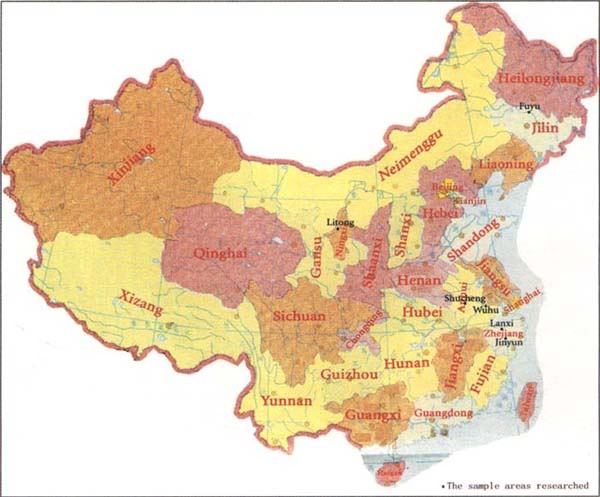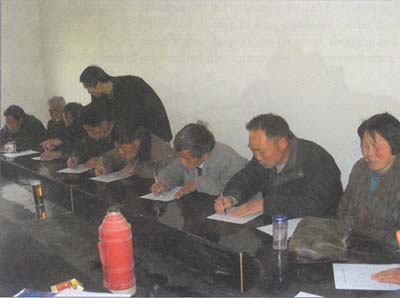With the rapid development of information technology and ever-sharpening competition in the global economy, many governments attach great importance to the dissemination of information, or information services, and the application of communication technology in the field of agriculture. Information and network technologies are used extensively in developed countries and many developing nations now actively promote the spreading of market information services throughout their rural areas.
As the People's Republic of China is experiencing a new development stage, marked by its accession to the World Trade Organization (WTO), people in agriculture and rural areas now seek a wide range of information. To strengthen the development of rural market information systems and information services, the Chinese government produced several policies, including the proposed Outline of the Tenth Five-Year Plan for National Economic and Social Development and the Action Plan of Rural Market Information Service during the Tenth Five-Year Plan period, which were launched in 2001 (through the Ministry of Agriculture). Corresponding policies also were generated in provinces (municipalities and autonomous regions) to implement the central strategies and promote information services systems in rural areas.
A rural market information services network connecting provinces, cities, counties and the majority of townships gradually has been established and links the leading enterprises of agriculture, wholesale markets, intermediary agencies and large households of production and business operations. Many locales stress the roles of the news media, agricultural socialized service organizations,[1] the agricultural television and broadcast school[2] and the Internet. Efforts also have been made in human resource development to further stretch the dissemination network to townships and villages and facilitate a wider flow of market information. The different delivery methods of information are achieving good results and are popular among farmers.
These methods recently captured the attention of the Food and Agriculture Organization of the United Nations (FAO). To analyse the different methods as a way of identifying gaps and enhancing the strengths and thus create models for other regions of China and possibly other developing countries, the FAO established a study group through the Information Centre of the Ministry of Agriculture in January 2003. The study group researchers conducted surveys and drafted case studies of the various information services in rural China.
From March to April 2003, the researchers designed the enquiry, collected basic data and conducted field studies in four counties, one city and one district in four provinces. After careful sorting, analysing and expert consultation, this comprehensive report was prepared, detailing and comparing the three main methods, or models, of information dissemination in China's rural areas.
By looking at a small variety of locales in rural China, the researchers aimed to achieve the following three objectives:
1) Assess the current situation of information services in a portion of rural China
To gain an in-depth understanding of the status of the current information services, the researchers wanted to look at how the services are organized in the sample areas (including human resources, software, hardware and connectivity of the network), funding sources and costs of providing information, content, farmers' information needs and the impacts generated.
2) Identify successful information service methods
By looking at how different methods were developed and their current status, the researchers planned to present models of methods that could be suitable for a variety of agricultural areas with varying economic development.
3) Provide useful references for replicating the good practices
By analysing the successful methods and the factors contributing to the success and by comparing the advantages and disadvantages of each, the researchers wanted to provide models of information services that could be established elsewhere.
Because the study involves both social and natural sciences with a broad spectrum of fields, there were many challenges. To ensure smooth access and quality research, the study group adopted a participatory approach with the involvement of relevant actors from central, provincial, city, county (district), township and village organizations and specialists, government officials, grassroots information service workers, managers of rural enterprises and farmers. The researchers combined theoretical and substantive evidence studies and quantitative and qualitative analysis to achieve in-depth understanding.
Four criteria determined the sample areas: 1) Varying economic development levels must be represented. At present, the economic development level in China decreases from the eastern regions towards the central and even more to the west regions of the country; 2) Various predominant agricultural products must be represented. Agriculture in the southeastern part of the country is dominated by vegetables, fruits, tea and other cash crops, silkworm raising and fisheries; the northeast is the major grain production area of the country; the central eastern region is a significant producer of grain, cotton and oil crops; while fruits, livestock and other unique products dominate agricultural production in the central and western regions; 3) The methods should be relatively successful; and 4) The methods should differ in the way they disseminate information.

Figure 1: Map of study sites in the People's Republic of China
Based on those factors, the researchers settled on the six sites for their studies, as shown in Figure 1: Jinyun county and Lanxi city in Zhejiang province in the southeast; Fuyu county in Jilin province in the northeast; Wuhu and Shucheng counties of Anhui province in central eastern area; and Litong district of Ningxia Hui Autonomous Region in the western area.
A combination of static and dynamic methods was adopted to collect the data. Prior to the field studies, the researchers collected relevant data on China and the sample areas through the Internet, newspapers, periodicals and questionnaires sent to research sites in advance. While in the field, the researchers visited county administration departments and service provision agencies, townships and village officials, farmer households, leading enterprises and specialized associations of farmers. As well, they organized a number of discussion sessions with government officials, information service workers and users and nonusers of information services. The researchers also used a questionnaire survey with many farmers in an attempt to assess the degree of satisfaction that they attributed to the information services in their area.
Once the field studies were completed, the researchers relied on telephone and e-mail communication to clarify issues or obtain more details. As well, they followed up with supplementary studies to confirm ideas and acquire more accurate and detailed information and materials from grassroots information service agencies.

Figure 2: Questionnaire survey conducted by the study group researchers in Yangshan village, Shucheng county
A method of combining horizontal and vertical comparison analysis was used to identify common features and analyse the reasons contributing to the success of the service models and the difficulties and challenges faced by each. To help practitioners and anyone else interested in establishing an information dissemination service, key issues have been highlighted in this document to aid in replicating the three different models.
|
[1] The government of China is
encouraging multi-organizations, which include NGOs, village collective economic
organizations, township agricultural technology, economic management,
agricultural machinery, planting protection, forestry, water conservation and
animal husbandry stations, as well as agricultural science, research and
educational organizations and specialized associations and cooperatives, to
offer services to farmers on agricultural technology, education, market
information, etc. [2] Agricultural broadcast and television school is the short name of the Central Agricultural Broadcast and Television School of China, which has many branches at province and county levels throughout the country. |